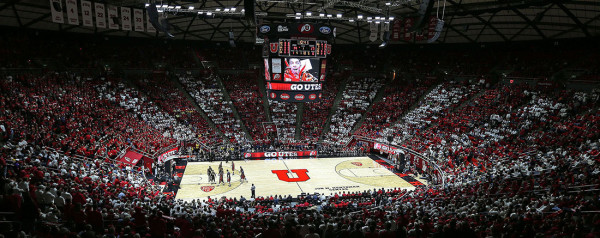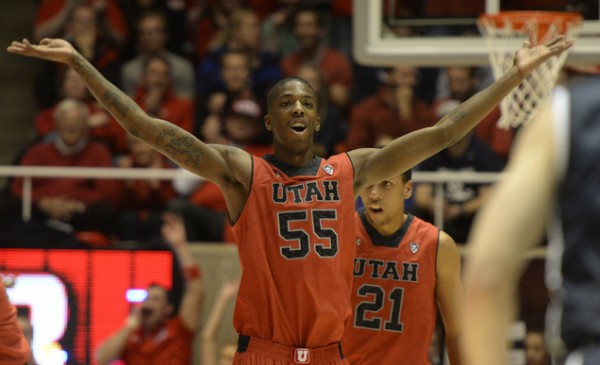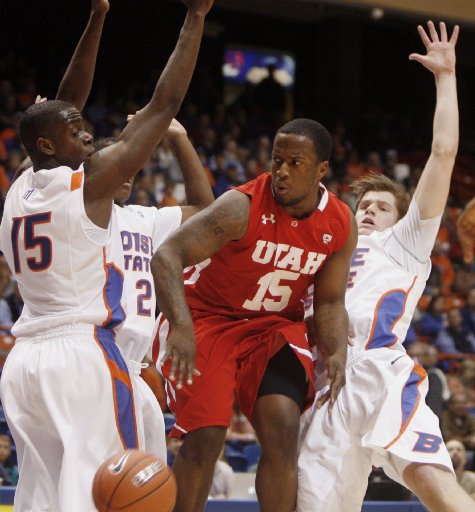On the Rise Of Utah Basketball
Posted by Andrew Murawa (@AMurawa) on February 26th, 2015On Saturday, Arizona will travel to Utah for a game with major implications to the Pac-12 regular season title picture. Any casual basketball fan knows the general story of Sean Miller and his refresh of the Wildcats program – a program with a proud history returned to elite status following the bumpy ending of the Lute Olson era. What many may not recognize is that the Utes are following a similar path. Following the stability and excellence of the 14 years of the Rick Majerus era (which featured no losing records, 10 seasons with at least 24 wins, a Final Four and 11 NCAA Tournament appearances), the Utes burned through two coaches in seven years and suffered four losing seasons over that volatile stretch. Compared with Arizona’s post-Olson struggles, Utah’s downturn was far more pronounced. But through the combination of the right hire, rampant roster revamping and, let’s face it, some good luck, the Utes have come out the other side of their dark period as a member of a power conference and back to national contention.

After A Rough Transition Post-Majerus, Utah Basketball Is Back In Its Rightful Place. (Utah Athletics)
The 2010-11 season was a great example of mixed emotions around the Utah basketball program. There was the excitement that the Utes were headed to a new conference – the newly named Pac-12 – in the following season. But at the same time, the current edition of the team was struggling to a tie for sixth place in the Mountain West as head coach Jim Boylen wrapped up his four-year stint with a third losing conference record. The program was coming off a season in which five players (including some guy named Marshall Henderson, and another one named Carlon Brown – who went on to be a Pac-12 Tournament MVP in leading Colorado to an NCAA bid in 2012) had transferred out of the program. Boylen was subsequently fired, and after a search that included St. Mary’s Randy Bennett and former Alabama head coach Mark Gottfried as candidates, Montana’s Larry Krystkowiak was named the new head coach on April 2, 2011.
Things in Salt Lake City had to get worse before they got better, and in that first offseason, another seven players — including current San Diego State starter J.J. O’Brien and former Iowa State stud Will Clyburn — transferred out of the program. The resultant 2011-12 season was the absolute nadir of the Utah basketball program: a 6-25 record in a season when point guard Josh Watkins was dismissed from the program. For a program with 27 NCAA Tournament appearances, four Final Fours and one NCAA title, you had to go back to 1928-29 and a 17-game season to find a Utes team with fewer wins.
But even in the tumult of that season, Krystkowiak began sowing the seeds for future success. First, there was the Watkins dismissal in which Krystkowiak established himself as a no-nonsense coach with the best interests of his players at heart. Despite kicking Watkins (who was leading the team in points and assists and wound up the year with the highest assist rate and rate of possessions used on KenPom) off the team, Krystkowiak stood by his player’s side and was one of his proudest supporters when Watkins graduated from the university that spring. The second big sign of things to come was the fact that the team managed to keep fighting in each game to the very end, earning three conference wins including a late-February win over Stanford that probably kept the Cardinal out of the NCAA Tournament. In reality, while that 6-25 record is exceptionally ugly, it probably represents an over-achievement for that roster.
Following that season, there was another complete roster remake – the third in three years. Seven more players left Utah, including five guys who had just entered the year before. Among the guys who took those departed roster positions are five players currently on the Utah roster:
- Jordan Loveridge, the first major recruiting pull for Krystkowiak, the best recruit in Utah, and a sign that the program was finding some solid ground.
- Brandon Taylor, a 5’9” point guard from Los Angeles who was generally regarded as not a Pac-12 level recruit.
- Dakarai Tucker, another southern California recruit, a long and athletic wing who would help the team’s overall athleticism but who earned just eight words in the 2012-13 Blue Ribbon yearbook.
- Dallin Bachynski and Jeremy Olsen, two big guys returning from LDS missions to provide size, depth and experience along the front line.
Each one of these recruits was a solid building block for the Utes, but the team was still under-talented and its eventual 15-18 record represents something of an over-achievement. A sixth newcomer – Loyola Marymount graduate transfer Jarred DuBois – not only played a key role on that season’s squad, but also played a major part in the development of the future Utah roster. In the 2013 offseason, there were three more transfers (bringing the running total to something like 22 over the course of four seasons) and three graduates (by comparison, only six total players completed their eligibility as active players with the Utes over those four seasons), freeing up six roster spots. But it was the impact of just one of those newcomers who changed the program from an afterthought to a contender. Utah beat out Washington, Washington State, Gonzaga and Saint Mary’s for the services of junior college transfer Delon Wright, a guy who was largely underrecruited out of high school but who had turned a year at a prep school and two years at City College of San Francisco into a path to the Pac-12. Krystkowiak’s and DuBois’ (a close friend of Wright’s) tag-team recruiting effort was almost an afterthought at the time, but two years later, as Wright contends for All-America honors on a top-10 team, it clearly represents the most fortunate turn of events for the Utes.

With Delon Wright, The Utah Program Got The Star Power It Needed. (Rick Egan, The Salt Lake Tribune)
Prior to last season, reports from Utah preseason practices revealed that not only was Wright the clear front-runner to start at point, but he was the team’s best player. When the Utes opened that season with a win by a margin of 84 points over Evergreen State, a game of which Wright made seven of eight field goals on the way to 17 points, 10 boards, seven assists, seven steals and three blocks, interest was most definitely piqued. The Utes didn’t play the strongest preseason schedule that year, but continued impressive performances against Boise State, Fresno State and BYU solidified those rising expectations, and his production never really dropped off all season long. Still, the young Utes had trouble compiling victories, struggling on the road (2-9) and in close games (3-8 in games decided by two possessions or less) as they learned how to play together. The good news is that they played almost everyone tight (conveniently forgetting that Pac-12 Tournament game) and, with almost their entire roster returning, laid the groundwork for this breakthrough season.
For the first time in nearly five years, the summer of 2014 around the Utah basketball program featured no major upheaval. Sure, there were another three outgoing transfers, but none of the three (Princeton Onwas, Ahmad Fields, Marko Kovacevic) left the Utes short-handed. Most importantly, there was a five-man recruiting class entering, each of whom has contributed to this team this season.
- Jakob Poeltl, an Austrian seven-footer whose commitment the Utes won through a combination of hard work and good, old-fashioned luck.
- Chris Reyes, a former Saint Mary’s recruit who spent last year at a junior college, Reyes has started all 27 games for the Utes and been a much-needed junkyard dog.
- Brekkot Chapman, the best recruit in the state of Utah for the 2014 class, confirmed Krystkowiak’s pull in the state is growing.
- Kyle Kuzma, a long and skilled wing whose best days are ahead of him, but who has shown flashes of brilliance.
- Isaiah Wright, quite possibly the point guard of the future, who has spent most of 2014-15 learning under Delon Wright’s leadership.
Two minutes into this season, Poeltl announced his ability to the conference and the nation.











































